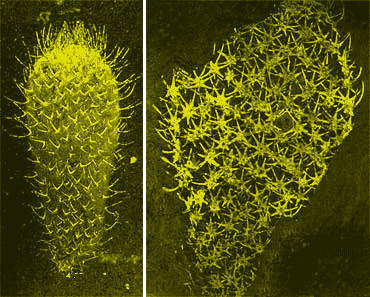A rare 520-million-year-old fossil shaped like a ‘squashed bird’s nest’ has been discovered by a Chinese team of paleontologists. The team believes that the fossil, which is in excellent shape, will help us better understand how the Earth’s seas were like during the Cambrian.The fossil probably belongs to the ‘chancelloriid’, a group of bizarre, balloon-shaped creatures over which scientists are still argueing.

Credit: Copyright Prof Derek J Siveter of Oxford University
The Cambrian Explosion
The Cambrian is one of the most fascinating geological stages in our planet’s development. Life was starting to evolve and fill out all the environmental niches, and all sorts of bizarre life forms were popping up. You can regard it as a period of evolutionary experiments. Also, during the Cambrian, most most major animal phyla appeared, as indicated by the fossil record. Additionally, the event was accompanied by major diversification of other organisms.
Among the strange creatures which emerged during the Cambrian, we have the chancelloriids – sessile, bag-like organisms with a soft skin armored with star-shaped calcareous sclerites from which radiate sharp spines. There are very few complete fossils of chancellorrids, most of them being only spines or other fragments.
Tom Hearing, a PhD student from the Department of Geology who is working on the skeletons of Cambrian fossils, said:
“We usually only get the broken-up remains of ancient animal skeletons. With this specimen we can see how all the different parts of the skeleton stuck together. It tells us much about how early animals functioned, how they might have interacted with other animals, and how they might have protected themselves from predators.”

These creatures probably lived on muddy sea-floors, as their sclerites increase in size from the bottom to the top, and all had thickenings at the bases, which are regarded as anchors; they also featured star-shaped bases that lay flat against the body, probably for protection.
The thing is, we still don’t know what chancelloriids were; the prevaling theory until the early 2000s was that they were sponges, but more recently, paleontologists have found evidence that contradicts this theory and recently, some have argued that they are very similar to halkieriids, mobile bilaterian animals that looked like slugs in chain mail. It’s still not clear what family this species belongs to, and the discussion is still ongoing.
Old life, old seas
The idea here is that it’s important to understand this species not just to know it better – but also to understand its environment. Fossils are some of the best clues we have to understanding how the environment was in the past – even as far as 500 million years ago. In fact, most of the things we know about the Cambrian come from fossil studies. So if we could understand this sea-dwelling creature, we could better understand the seas.
The research team which found the fossil is led by Professor Xianguang Hou from the Yunnan Key Laboratory for Palaeobiology at Yunnan University in China with collaboration from the Universities of Leicester and Oxford. It’s probably a new species, and the team has already named it Nidelric pugio to honour the late Professor Richard Aldridge, a palaeontologist and keen ornithologist formerly of the University of Leicester’s Department of Geology and a scientist who was a world leader in Chengjiang fossil research. It is a sign of great respect paid. Dr Tom Harvey from the University of Leicester, a co-author of the paper, said:
“There is only one fossil of this enigmatic animal after 30 years of collecting by our Chinese colleagues at Chengjiang. It is exceptionally rare, but it shows us just how strange and varied the shapes of early animals could be.”
“We are glad the fossil can honour the name of Professor Richard Aldridge, who was a leader in this field and whose research was vital in better understanding the rich tapestry of fossils found at Chengjiang.”
For most fossils, it’s pretty clear where they fit in the tree of life, but every now and them (more often in the Cambrian than in other periods), you get a stand out – a mysterious fossil which just doesn’t seem to fit anywhere. It’s these fossils that provide an unprecedented view of life in Earth’s ancient seas. Hopefully, it’s exactly what this chanceloriid will do.
Journal Reference:
- Xianguang Hou, Mark Williams, David J. Siveter, Derek J. Siveter, Sarah Gabbott, David Holwell, Thomas H. P. Harvey. A chancelloriid-like metazoan from the early Cambrian Chengjiang Lagerstätte, China. Scientific Reports, 2014; 4: 7340 DOI: 10.1038/srep07340


